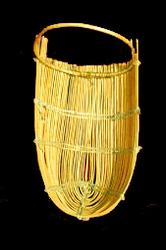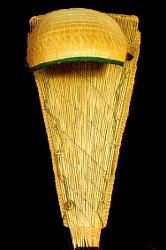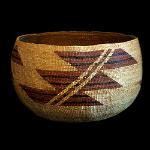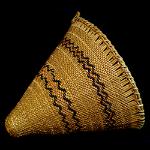| ART OF THE CALIFORNIA INDIANS |
| CALIFORNIA CRADLEBOARDS Cradleboards or baby carriers were utilized by almost all of the tribes of North America. Remnants of cradles have been found dating back to as early as 1200 A.D. They were made in many different styles, but all served the same basic purpose to transport or carry an infant. Cradles were produced throughout all regions of California and were made of basketry materials such as willow, reed, tule, or roots. The two basic forms of cradles in California were a “sitting cradle,” and “slipper-shaped cradle,” which usually included a hood or sunshade. The sitting cradles were scoop-=shaped and usually made with bent willow rods. These cradles were made by the Pomo, Wintun, and other tribes in the central region of California. The slipper-shaped cradles were generally made in the Northern areas by the Hupa, Yurok, and Karok tribes, and were usually made of hazel rod and root fiber. Among the Paiute tribes in Eastern California, the cradles were usually skin-covered with a curved hood and decorated with beadwork. These cradles resembled those of the Plains and Great Basin areas because of their close proximity. Symbolic designs were created on the Paiute cradleboards to indicate the sex of the baby. Most infants spent much of their early life in the cradles from the moment of birth, until they able to walk. Sometimes objects such as feathers or beads were dangled from the hood of the cradles to occupy and entertain the infant. The cradles could be carried in the arms or by a strap which was passed across the mother’s forehead or chest. Cradleboard images courtesy of Red Earth Museum Oklahoma City, Ok |




| Pomo |
| Hupa |
| Paiute |
| Mono |

| CALIFORNIA BASKETS Baskets are one of the oldest forms of storage and transportation of food and water. Native grasses, roots and tree shoots were among the most abundant natural materials available for basket weaving. Baskets were originally woven to serve utilitarian purposes in everyday life such as cooking, gathering and storage. Conical shaped burden baskets were used to gather food items such as acorns, roots, berries and seeds. Winnowing baskets were used to separate seeds from hulls. Large woven baskets were used for cooking and preparation of food. Other special baskets were woven for gaming and ceremonial purposes. The women also wove basket “hats.” There are three basic techniques involved in basket production. The earliest known is “twining,” where the “wefts” or moving elements, twist around the foundation elements or “warps.” Another technique is “coiling,” where the base element is coiled and held in place by the wrapping elements. The third technique is “plaiting,” where the warps and wefts are woven over and under each other in a particular pattern. The California Indians used the twining and coiling techniques exclusively and excelled in the production of beautiful baskets. There is much diversity among California baskets, from the finely twined baskets and hats of the Northern Hupa, Yurok, Karuk, Shasta, Modoc and Achumawi tribes, to the coiled baskets of the extreme Southern “Mission” tribes of the Chumash, Kumeyaay, Serrano, Cahuilla, Diegueno, Gabrielino, Mohave and Yuma. In between, the north-central tribes of the Pomo, Maidu, Miwok, and Wintu used materials such as bear grass, sedge grass, fern stems and roots, pine roots, willow shoots and redbud. They produced both twined and coiled basketry including large burden baskets. The southern tribes utilized materials of juncus rush, willow, deer grass, sumac and devil’s claw (martynia.) Another area was that of the Great Basin tribes which included the Northern Paiute, Washo, Mono, Tubatulabal, Panamint, Kawaisu and Chemehuevi. The basin area is situated between multiple mountain ranges and stretches over 100 miles south into the more arid, desert- like regions. In northern regions of the Great Basin, materials included willow, redbud, bracken fern root and sumac. In southern regions, desert willow, yucca, grasses, sumac, and martynia were primary materials. |










| Hupa Basket ca. 1940s |
| Hupa CeremonialTray ca. 1940s |
| Hupa Woman's Hat ca. 1920s |
| Yurok/Karuk Mush Bowl ca. 1930 |
| Maidu Burden Basket ca. 1920s |
| Mono Sifting Basket ca. 1970s |
| Paiute Conical Basket ca. 1900 |
| Washoe Conical Basket ca. 1920s |
| Western Mono Conical Basket ca. 1950s |
| Yokut Cooking Basket ca. 1930s |
| Yurok Karuk ca. 1900-1910 |
| native american art |
| HOME |
